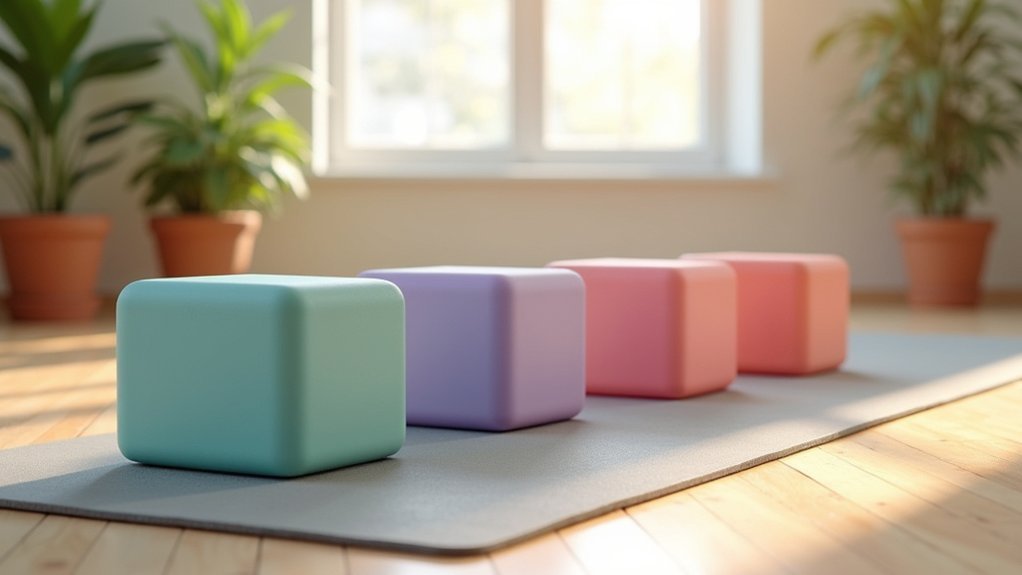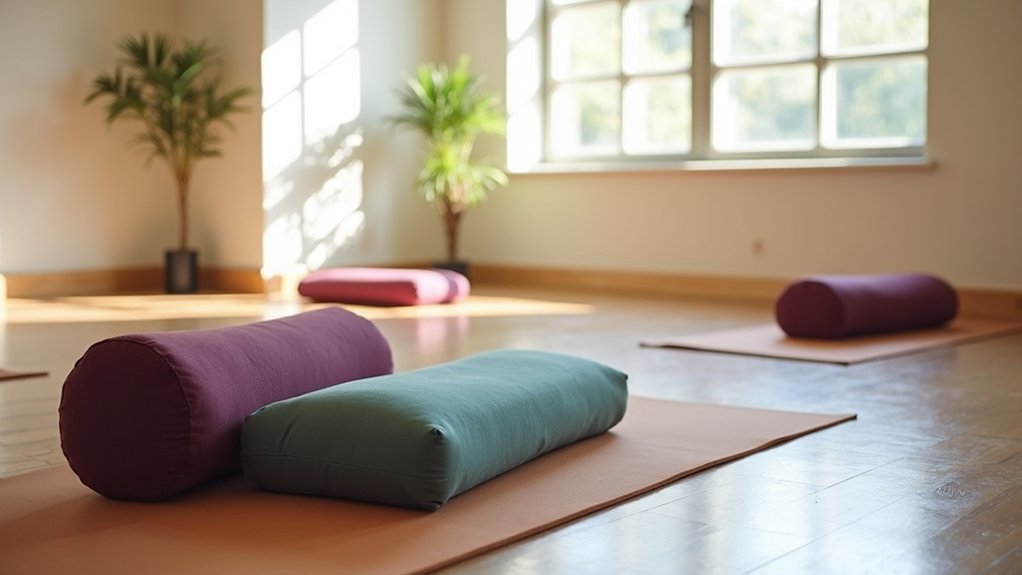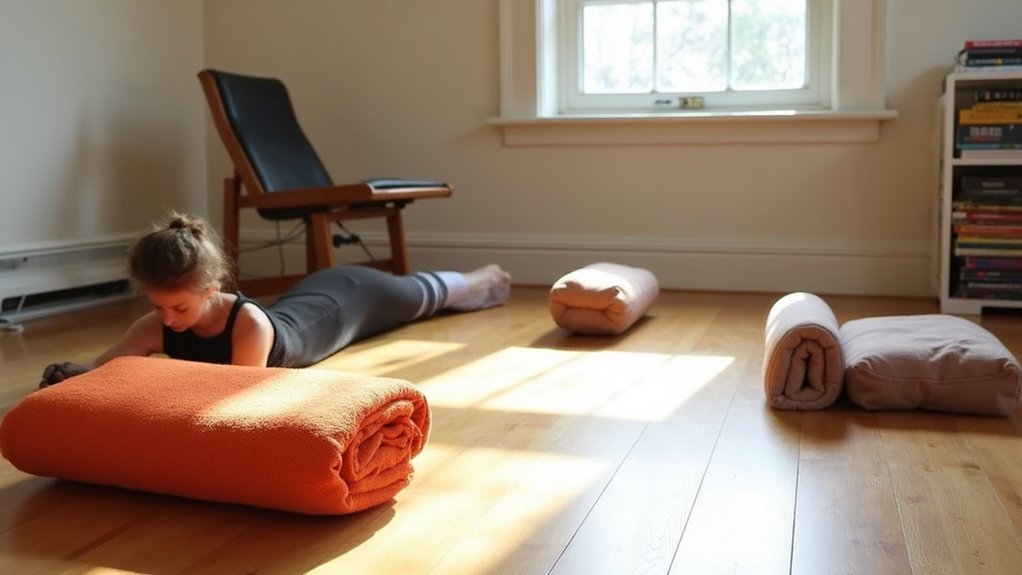Five essential yoga props that make your practice more accessible include blocks, straps, bolsters, chairs, and everyday household items. Blocks elevate the floor during forward folds, while straps extend your reach for deeper stretches. Bolsters and cushions provide support during restorative poses, and chairs help maintain balance for those with limited mobility. You can also substitute items from home like books, belts, and pillows. Discover how these tools can transform your practice regardless of your body type or experience level.
Yoga Blocks: Elevating Accessibility and Stability

When practitioners first encounter yoga blocks, they often discover a transformative tool that bridges the gap between aspiration and ability.
These versatile props elevate the floor in poses like forward folds and low lunges, making your practice of yoga more accessible regardless of flexibility limitations.
Many yoga instructors recommend the Jade Cork Yoga Block ($14.95), which is both sustainable and durable.
You’ll find these props in every yoga studio because they provide support for various body types and abilities.
Whether placed under your hands in standing poses or between your thighs in seated postures, blocks help improve flexibility while maintaining proper alignment.
Yoga Straps: Extending Reach and Enhancing Flexibility
Three key benefits define yoga straps as essential tools for practitioners at all levels. They enhance flexibility, improve alignment, and make challenging poses more accessible.
Yoga straps unlock new dimensions in your practice, bridging the gap between current limitations and future possibilities.
When you’re working on tight hamstrings or limited shoulder mobility, a quality strap like the 8-foot Hugger Mugger ($16.95) becomes your trusted practice partner.
- Safety first – Straps prevent overstretching while allowing you to deepen your practice
- Extended reach – Elongate your arms’ reach in poses like dancer or legs up the wall
- Better alignment – Maintain proper form during seated forward folds
- Restorative support – Create comfortable, supported positions for restorative yoga
You’ll find your yoga practice transforming as the strap helps you safely explore poses that once seemed impossible, fostering confidence regardless of your flexibility level.
Bolsters and Cushions: Creating Supportive Foundations

Support and comfort form the foundation of restorative yoga practice, with bolsters and cushions serving as essential tools for practitioners seeking deeper relaxation and proper alignment.
These versatile props provide firm support during poses like wheel and seated forward fold, making your yoga practice more accessible regardless of flexibility level.
When you incorporate bolsters or cushions into your routine, you’ll experience less strain on your lower back and hips, allowing you to maintain proper alignment while safely deepening stretches.
Many are crafted from organic cotton, offering eco-friendly durability alongside comfort.
Cushions can effectively substitute for bolsters, providing similar benefits during seated meditation or relaxation poses.
Chairs as Versatile Practice Partners
Though often overlooked in traditional yoga settings, chairs represent one of the most accessible and adaptable props available to practitioners of all abilities.
Chair yoga transforms the ordinary into extraordinary, making mindful movement accessible to every body, regardless of physical limitations.
You’ll find chairs particularly helpful if you have limited mobility or are recovering from an injury, as they elevate the floor and provide essential stability during your yoga practice.
- Support during challenging poses – Chairs help you maintain balance while focusing on alignment and breath
- Accessibility for diverse populations – Chair yoga classes make the practice inclusive for those who struggle with floor-based poses
- Versatility in position – Use chairs for seated, standing, or balancing poses with equal effectiveness
- Community availability – Many yoga studios now offer specialized chair yoga classes recognizing their value as essential yoga props
Adaptive Props From Everyday Household Items

While yoga studios and specialized shops offer a range of dedicated props, you don’t need to invest in expensive equipment to enhance your practice. Your home already contains effective alternatives to traditional yoga props.
A sturdy footstool works perfectly in place of yoga blocks, elevating your hands during forward fold poses.
Can’t reach your feet? Grab a fabric belt from your bathrobe or judo uniform to create an improvised yoga strap that helps you extend without straining.
Chair yoga becomes accessible with any stable chair, making practice possible for those who can’t easily get to the floor.
For comfort during restorative poses, a simple blanket or towel replaces specialized bolsters or an expensive yoga mat.
Your walls provide natural support for balance poses, making your practice both safe and accessible.
Frequently Asked Questions
What Kinds of Yoga Props Can Be Used to Aid Balance in a Yoga Practice?
You’ll improve balance with yoga blocks elevating the floor, straps helping elongate arms, walls stabilizing challenging poses, chairs aiding in chair-based yoga, and anti-slip mats providing secure foundations during your practice.
What Are the Benefits of Props in Yoga?
Props make yoga more accessible for you, improving alignment and comfort. They’ll prevent injuries by offering support where you need it, allowing deeper stretches safely. You’ll enjoy a more personalized, inclusive practice with props.
What Is the Most Well Known Yoga Prop?
The yoga block is the most well-known yoga prop you’ll encounter. It’s typically made from foam, cork, or wood and costs around $14.95. You’ll find it indispensable for modifying poses and improving reach.
What Is the Most Restorative Yoga Pose?
Savasana (Corpse Pose) is the most restorative yoga pose. You’ll experience deep relaxation as your body fully rests. It’s typically practiced at the end of sessions, allowing you to integrate your practice’s benefits.
In Summary
You don’t need expensive equipment to make yoga work for your body. With these simple props, you’ll discover new possibilities in your practice, regardless of your flexibility, strength, or mobility level. Remember, using props isn’t “cheating”—it’s smart practice that honors where you are today. Start with what you have at home, add specialized items as needed, and enjoy a more comfortable, sustainable yoga journey.





Leave a Reply